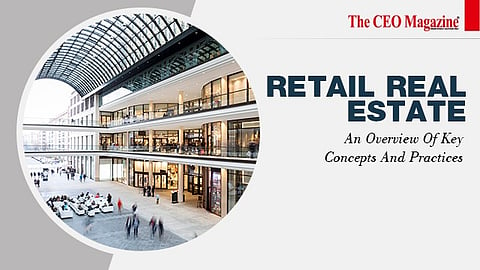

Retail Real Estate
Retail real estate is a type of commercial property that is designed and used for retail purposes. Retail real estate is typically located in prime commercial areas and is used by various businesses, including retail stores, restaurants, and entertainment venues.
In this article, we will provide an overview of the key concepts and practices related to retail real estate, including its properties, types, and applications.
Retail real estate is a type of commercial property that is designed and used for retail purposes. Retail real estate is typically located in high-traffic areas and is used by various businesses, including retail stores, restaurants, and entertainment venues.
Retail real estate is an important component of the commercial real estate market, with a significant impact on the economy and society as a whole.
Retail real estate properties come in various sizes and shapes, from small stand-alone stores to large shopping malls. Businesses, investors, or real estate development companies may lease or own the properties. The key properties of retail real estate include location, accessibility, visibility, and zoning regulations.
Location is a critical property of the retail real estate. The best locations for retail real estate are those with high foot traffic, easy accessibility, and proximity to major transportation routes.
Retail real estate located in downtown areas or close to residential neighbourhoods tends to be more valuable than those located in rural areas or industrial parks.
Accessibility is another important property of the retail real estate. Retail properties should be easily accessible by both pedestrian and vehicular traffic. Parking facilities, public transportation, and other amenities can also enhance the accessibility of retail properties.
Visibility is another important property of the retail real estate. Retail properties that are highly visible to the public tend to attract more customers and generate more revenue. Signage, lighting, and building design can all impact the visibility of retail properties.
Zoning regulations are also important properties of retail real estate. Zoning regulations determine what types of businesses can operate in a particular location and can impact the value and use of the retail real estate.
There are several types of retail real estate, each with its own characteristics and purposes. Some of the most common types of retail real estate include:
Strip Malls: A strip mall is a row of small retail stores located in a single building or complex.
Regional Malls: A regional mall is a large indoor shopping centre that typically includes department stores, speciality stores, restaurants, and entertainment venues.
Lifestyle Centers: A lifestyle centre is a shopping centre that combines traditional retail stores with outdoor spaces and entertainment venues.
Power Centers: A large outdoor shopping centre typically includes big-box retailers, such as home improvement stores and grocery stores.
Retail real estate has numerous applications and impacts on the economy and society. Some of the most common applications of retail real estate include
Job Creation: Retail real estate creates jobs for retail workers, management staff, and support personnel.
Revenue Generation: Retail real estate generates revenue for businesses, landlords, and local governments through sales taxes, property taxes, and rental income.
Consumer Convenience: Retail real estate provides consumers with convenient access to goods and services, saving time and effort.
Economic Development: Retail real estate can attract new businesses and industries to an area, contributing to economic growth and development.
Retail real estate is a critical component of the commercial and wholesale real estate market, with a significant impact on the economy and society as a whole. The key properties of retail real estate include location, accessibility, visibility, and zoning regulations.
There are several types of retail real estate, each with its own characteristics and purposes. Retail real estate has numerous applications and benefits, including the economic growth of a country.
Follow us on Google News
